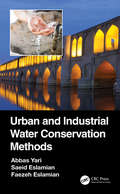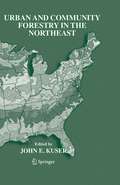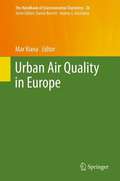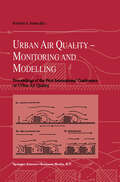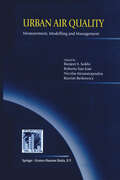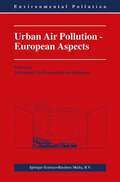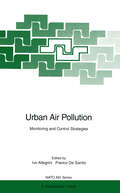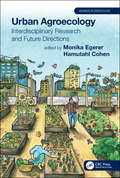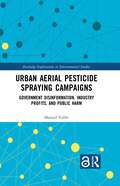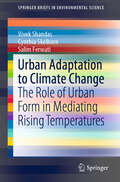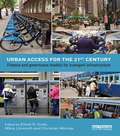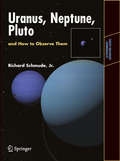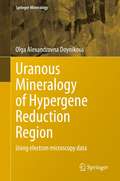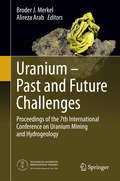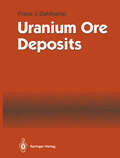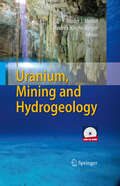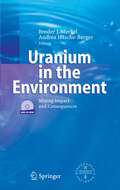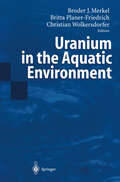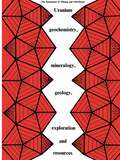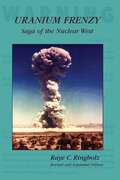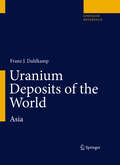- Table View
- List View
Urban and Industrial Water Conservation Methods
by Abbas Yari Saeid Eslamian Faezeh EslamianUrban and Industrial Water Conservation Methods provides comprehensive and practical information regarding water use for various different sectors and describes the most suitable conservation devices and techniques to reduce water consumption in urban environments. It demonstrates how these conservation devices and best practices can greatly and quickly increase the efficiency of water use in both new and existing buildings. Features: Examines conservation devices and techniques across residential, commercial, and institutional sectors. Provides practical advice on implementing water conservation methods for users across various industries. Explains how to quickly improve water efficiency by using cost-effective water-saving devices and techniques. Includes relevant international case studies to reinforce the content. Written by practicing water conservation consultants for a wide audience, including municipality authorities and decision-makers, researchers, and students alike, Urban and Industrial Water Conservation Methods applies to residential, commercial, institutional, and industrial end users.
Urban and Industrial Water Conservation Methods
by Abbas Yari Saeid Eslamian Faezeh EslamianUrban and Industrial Water Conservation Methods provides comprehensive and practical information regarding water use for various different sectors and describes the most suitable conservation devices and techniques to reduce water consumption in urban environments. It demonstrates how these conservation devices and best practices can greatly and quickly increase the efficiency of water use in both new and existing buildings. Features: Examines conservation devices and techniques across residential, commercial, and institutional sectors. Provides practical advice on implementing water conservation methods for users across various industries. Explains how to quickly improve water efficiency by using cost-effective water-saving devices and techniques. Includes relevant international case studies to reinforce the content. Written by practicing water conservation consultants for a wide audience, including municipality authorities and decision-makers, researchers, and students alike, Urban and Industrial Water Conservation Methods applies to residential, commercial, institutional, and industrial end users.
Urban and Community Forestry in the Northeast
by John E. KuserThis book is a textbook for Urban/Community Forestry courses and a handbook for Shade Tree Commissions, tree wardens, State and National Forestry Services, and professional societies. It is the most complete text in this field because it addresses both culture and management, and the chapters have been written by experts who are active practitioners. The book provides observations and examples relevant to every urban center in the U.S. and elsewhere.
Urban Air Quality in Europe (The Handbook of Environmental Chemistry #26)
by Mar VianaThis book provides an overview of air quality in urban environments in Europe, focusing on air pollutant emission sources and formation mechanisms, measurement and modeling strategies, and future perspectives. The emission sources described are biomass burning, vehicular traffic, industry and agriculture, but also African dust and long-range transport of pollutants across the European regions. The impact of these emission sources and processes on atmospheric particulate matter, ozone, nitrogen oxides and volatile and semi-volatile organic compounds is discussed and critical areas for particulate matter and nitrogen dioxide in Europe are identified. Finally, this volume presents future perspectives, mainly regarding upcoming air quality monitoring strategies, metrics of interest, such as submicron and nanoparticles, and indoor and outdoor exposure scenarios.
Urban Air Quality: Proceedings of the First International Conference on Urban Air Quality: Monitoring and Modelling University of Hertfordshire, Hatfield, U.K. 11–12 July 1996
by Ranjeet S. SokhiThe increasing concern over environmental and health impact of urban air pollution has lead to a growing need for an international conference focussing specifically on urbanised regions. Although, air quality has gained importance through out the world, it is especially in areas of high urban development that the problems are particularly acute. Scientific interest in this field is particularly evident from the growing number of journal publications and conference presentations. The numerous conferences held every year on air pollution, however, have tended to encompass a broad theme and have not specifically focussed on the urban environment. In order to address this need an international conference on urban air quality was organised by the Environmental Physics Group of the Institute of Physics in collaboration with the Royal Society of Chemistry (RSC), The Royal Meteorological Society (RMS) and the National Society for Clean Air and Environmental Protection (NSCA). Over 100 participants from various countries attended this first international conference on urban air quality. The aim of the conference was to provide a forum for open scientific discussion on the latest advances in the field of urban air quality monitoring and modelling. The range of topics included: chemical and biogenic pollutants, monitoring techniques, instrumentation, analysis of pollutants, spatial and temporal interpretation of air quality data, emission sources and modelling of air quality. All papers submitted for publication were peer reviewed and consequently, some articles were not successful in the refereeing process and have not been included in this special issue.
Urban Air Quality: Proceedings of the Second International Conference on Urban Air Quality: Measurement, Modelling and Management Held at the Computer Science School of the Technical University of Madrid 3–5 March 1999
by Ranjeet S. Sokhi Roberto San José Nicolas Moussiopoulos Ruwim BerkowiczSince the first international conference on urban air quality, held at the University ofHertfordshire in 1996, significant advances have taken place in the field of urban air pollution. In addition to the scientific advances in the measurement, modelling and management of urban air quality, significant progress has been achieved in relation to the establishment of major frameworks to ensure a more effective mechanism for international collaboration. Two such frameworks are SATURN (Studying Atmospheric Pollution in Urban Areas) and TRAPOS (Optimisation of Modelling Methods for Traffic Pollution in Streets). In response to such advances, the second international conference was held at the Technical University of Madrid in March 1999 with active participation of SATURN and TRAPOS investigators. The organisation of the conference was headed by the Institute of Physics in collaboration with the Technical University of Madrid and the University of Hertfordshire. The support of IUAPPA and AWMA ensured a truly worldwide promotion and participation. The meeting attracted 140 scientists from 26 different countries establishing it as a major forum for exchanging and discussing the latest research fmdings in this field.
Urban Air Pollution - European Aspects (Environmental Pollution #1)
by Brian J. AllowayThis European Community-initiated book presents an up-to-date account of the air pollution situation with special reference to European cities. Its structure follows by and large the logical chain of events in air pollution, from sources, through dispersion and deposition, to impacts.
Urban Air Pollution: Monitoring and Control Strategies (Nato Science Partnership Subseries: 2 #8)
by Ivo Allegrini Franco DeSantisThis book presents the proceedings of a NATO Advanced Research Workshop which was also financially supported by the National Research Council of Italy. The Workshop was held from October 9 to 15, 1994, at the Centro Ettore Maiorana in Erice, Italy. Over 40 researchers from a wide variety of fields attended the Workshop, which brought to attention the ongoing research on various phenomena related to urban air pollution. The presence of high levels of atmospheric pollutants in the air of several urban centres of developed and developing countries causes a great concern among authorities and public opinion. Some 20% of the European population live in cities of more than 500,000 inhabitants and about 40% in cities of more than 50,000. Since exceedance of the Air Quality Guidelines has been observed to occur worldwide, a great effort has been addressed to the control of primary pollutants, but many problems related to secondary pollutants such as nitrogen containing species (nitrogen oxides, nitric and nitrous acid, ni trates) and photochemical oxidants (ozone, PAN and others) are far from being solved. The importance of atmospheric chemistry in understanding the processes occurring in urban atmospheres has been well recognised, thus there is a strong need to exchange experiences and results from urban centres in different Countries. Indeed, atmospheric pollution is very much dependent on the type of emissions which are very different according to the economic development of the urban centre under consideration.
Urban Agroecology: Interdisciplinary Research and Future Directions (Advances in Agroecology #23)
by Monika Egerer Hamutahl CohenToday, 20 percent of the global food supply relies on urban agriculture: social-ecological systems shaped by both human and non-human interactions. This book shows how urban agroecologists measure flora and fauna that underpin the ecological dynamics of these systems, and how people manage and benefit from these systems. It explains how the sociopolitical landscape in which these systems are embedded can in turn shape the social, ecological, political, and economic dynamics within them. Synthesizing interdisciplinary approaches in urban agroecology in the natural and social sciences, the book explores methodologies and new directions in research that can be adopted by scholars and practitioners alike. With contributions from researchers utilizing both social and natural science approaches, Urban Agroecology describes the current social-environmental understandings of the science, the movement and the practices in urban agroecology. By investigating the role of agroecology in cities, the book calls for the creation of spaces for food to be sustainably grown in urban spaces: an Urban Agriculture (UA) movement. Essential reading for graduate students, practitioners, policy makers and researchers, this book charts the course for accelerating this movement.
Urban Agroecology: Interdisciplinary Research and Future Directions (Advances in Agroecology #23)
by Monika Egerer Hamutahl CohenToday, 20 percent of the global food supply relies on urban agriculture: social-ecological systems shaped by both human and non-human interactions. This book shows how urban agroecologists measure flora and fauna that underpin the ecological dynamics of these systems, and how people manage and benefit from these systems. It explains how the sociopolitical landscape in which these systems are embedded can in turn shape the social, ecological, political, and economic dynamics within them. Synthesizing interdisciplinary approaches in urban agroecology in the natural and social sciences, the book explores methodologies and new directions in research that can be adopted by scholars and practitioners alike. With contributions from researchers utilizing both social and natural science approaches, Urban Agroecology describes the current social-environmental understandings of the science, the movement and the practices in urban agroecology. By investigating the role of agroecology in cities, the book calls for the creation of spaces for food to be sustainably grown in urban spaces: an Urban Agriculture (UA) movement. Essential reading for graduate students, practitioners, policy makers and researchers, this book charts the course for accelerating this movement.
Urban Aerial Pesticide Spraying Campaigns: Government Disinformation, Industry Profits, and Public Harm (Routledge Explorations in Environmental Studies)
by Manuel ValléeThis book examines social processes that have contributed to growing pesticide use, with a particular focus on the role governments play in urban aerial pesticide spraying operations.Beyond being applied to sparsely populated farmland, pesticides have been increasingly used in densely populated urban environments, and when faced with invasive species, governments have resorted to large-scale aerial pesticide spraying operations in urban areas. This book focuses on New Zealand's 2002–2004 pesticide campaign to eradicate the Painted Apple Moth, which is the largest operation of its kind in world history, whether we consider its duration (29 months), its scope (at its peak the spraying zone was 10,632 hectares/26,272 acres), the number of sprayings that were administered (the pesticide was administered on 60 different days), or the number of people exposed to the spraying (190,000+). This book provides an in-depth understanding of the social processes that contributed to the incursion, why the government sought to eradicate the moth through aerial pesticide spraying, the ideological strategies they used to build and maintain public support, and why those strategies were effective.Urban Aerial Pesticide Spraying Campaigns will be of great interest to students and researchers of pesticides, environmental sociology, environmental history, environmental studies, political ecology, geography, medical sociology, and science and technology studies.The Open Access version of this book, available at http://www.taylorfrancis.com, has been made available under a Creative Commons Attribution-Non Commercial-No Derivatives (CC-BY-NC-ND) 4.0 license.
Urban Aerial Pesticide Spraying Campaigns: Government Disinformation, Industry Profits, and Public Harm (Routledge Explorations in Environmental Studies)
by Manuel ValléeThis book examines social processes that have contributed to growing pesticide use, with a particular focus on the role governments play in urban aerial pesticide spraying operations.Beyond being applied to sparsely populated farmland, pesticides have been increasingly used in densely populated urban environments, and when faced with invasive species, governments have resorted to large-scale aerial pesticide spraying operations in urban areas. This book focuses on New Zealand's 2002–2004 pesticide campaign to eradicate the Painted Apple Moth, which is the largest operation of its kind in world history, whether we consider its duration (29 months), its scope (at its peak the spraying zone was 10,632 hectares/26,272 acres), the number of sprayings that were administered (the pesticide was administered on 60 different days), or the number of people exposed to the spraying (190,000+). This book provides an in-depth understanding of the social processes that contributed to the incursion, why the government sought to eradicate the moth through aerial pesticide spraying, the ideological strategies they used to build and maintain public support, and why those strategies were effective.Urban Aerial Pesticide Spraying Campaigns will be of great interest to students and researchers of pesticides, environmental sociology, environmental history, environmental studies, political ecology, geography, medical sociology, and science and technology studies.The Open Access version of this book, available at http://www.taylorfrancis.com, has been made available under a Creative Commons Attribution-Non Commercial-No Derivatives (CC-BY-NC-ND) 4.0 license.
Urban Adaptation to Climate Change: The Role of Urban Form in Mediating Rising Temperatures (SpringerBriefs in Environmental Science)
by Vivek Shandas Cynthia Skelhorn Salim FerwatiThis book presents the findings of a three-year study on urban heat in Doha, Qatar, and discusses guidelines and strategies for planning agencies to consider in the context of moderating temperatures to provide pedestrians with greater access to outdoor spaces and greater choice in modes of transport. If modifying urban form can reduce extreme temperatures in one of the hottest places on the planet, then perhaps other communities can learn how to create livable cities during a time of rapid changes to the climate. In fact, despite the periods of extreme heat, strategic planning and management of urban areas can improve residents’ and visitors’ ability to live, work, and move throughout the city comfortably. Doha, Qatar, a city with one of the most extreme climates on earth, has undergone rapid development over the past 40 years. Although cities in the Middle East are expanding at three times the international average (UN Report, 2012), the rapid population and physical growth remain largely unexamined, particularly in terms of the unique conditions, qualities, and characteristics that give rise to these emerging centres. Speed, quality, and extent of urbanization impact neighbourhood-scale environmental conditions, and this book provides evidence that urban forms and materials can help to mediate temporal variation in microclimates and that landscape modifications can potentially reduce temperatures and increase accessibility to outdoor environments. By applying the lessons in this book, communities around the world can better adapt to the increasing frequency, duration and intensity of extreme heat.
Urban Access for the 21st Century: Finance and Governance Models for Transport Infrastructure
by Elliott D. Sclar Måns Lönnroth Christian WolmarThis book sets out a road map for the provision of urban access for all. For most of the last century cities have followed a path of dependency on car dominated urban transport favouring the middle classes. Urban Access for the 21st Century seeks to change this. Policies need to be more inclusive of the accessibility needs of the urban poor. Change requires redesigning the existing public finance systems that support urban mobility. The aim is to diminish their embedded biases towards automobile-based travel. Through a series of chapters from international contributors, the book brings together expertise from different fields. It shows how small changes can incentivize large positive developments in urban transport and create truly accessible cities.
Urban Access for the 21st Century: Finance and Governance Models for Transport Infrastructure
by Elliott D. Sclar Måns Lönnroth Christian WolmarThis book sets out a road map for the provision of urban access for all. For most of the last century cities have followed a path of dependency on car dominated urban transport favouring the middle classes. Urban Access for the 21st Century seeks to change this. Policies need to be more inclusive of the accessibility needs of the urban poor. Change requires redesigning the existing public finance systems that support urban mobility. The aim is to diminish their embedded biases towards automobile-based travel. Through a series of chapters from international contributors, the book brings together expertise from different fields. It shows how small changes can incentivize large positive developments in urban transport and create truly accessible cities.
Uranus, Neptune, and Pluto and How to Observe Them: And How To Observe Them (Astronomers' Observing Guides)
by Richard Schmude, Jr.This book is for two groups of people: those who want to study the remote planets with amateur astronomical equipment, and those who are just interested in learning about our knowledge of the remote planets. The Remote Planets, and How to Observe them is unique in that it gives a completely up-to-date summary of our current knowledge of the remote planets, and also explains how amateur astronomers can contribute to our knowledge of the remote planets. Readers are given some inspiring examples of people who, with modest commercially-made equipment, have made important contributions to our scientific knowledge. The observational section goes into great detail, including optical and CCD photometry, occultation measurements, imaging (including stacking and enhancement techniques) and polarization measurements. There are finder charts (from 2010 to 2026), complete with two sets of star-magnitudes in an appendix (one set of magnitudes are for photoelectric photometry and the other set is for visual photometry)
Uranous Mineralogy of Hypergene Reduction Region: Using electron microscopy data (Springer Mineralogy)
by Olga Alexandrovna DoynikovaThis book offers a comprehensive view of the valuable uranium ores and analytical electron microscopy methods, including electron microdiffraction principles, an essential technique for studying uranous minerals.This book also explains the laws governing the formation of uranium mineral accumulations, based on concepts published by the renowned Russian mineralogist L.N. Belova. It addresses all types of ore uranium concentrations in the hypergene region and schematizes all uranium mineral formation processes. Readers will also find selected examples of different genetic types of uranium deposits of black sooty ores; the data gathered from all findings on ningyoite worldwide, and new crystal chemistry data on tetravalent uranium phosphates.
Uranium - Past and Future Challenges: Proceedings of the 7th International Conference on Uranium Mining and Hydrogeology
by Broder J. Merkel Alireza ArabThis book is the collection of papers from the latest International Uranium Mining and Hydrogeology Conference (UMH VII) held in September 2014, in Freiberg, Germany. It is divided to five sessions: Uranium Mining, Uranium and Phosphates, Clean-up technologies for water and soil. Uranium and daughter nuclides and basic research and modeling. Each session covers a wide range of related topic and provides readers with up to date research and solutions on those matters.
Uranium Ore Deposits
by Franz J. DahlkampAn important prerequisite to the long-term use of nuclear energy is information on uranium ore deposits from which uranium can be economically exploited. Hence the basic purpose of this book is to present an overview of uranium geology, data characteristic for uranium deposits, and a synthesis of these data in the form of a typological classification of uranium deposits supported by more detailed descriptions of selected uranium districts and deposits. An additional goal is to provide access for the interested reader to the voluminous literature on uranium geology. Therefore a register of bibliography as global as possible, extending beyond the immediate need for this book, is provided. The volume presented here was not originally designed as a product for its own sake. It evolved as a by-product during decades of active uranium exploration and was compiled thanks to a request by the Springer Publishing Company. Routine research work on identifying characteristic features and recognition criteria of uranium deposits, combined with associated modeling of types of deposits for reapplication in exploration, provided the data bank. The publisher originally asked for a book on uranium deposits structured as a combined text- and reference book. The efforts to condense all the text into a single publication were soon doomed. The material grew out of all feasible proportions for a book of acceptable size and price, a wealth of data on uranium geology and related geosciences having become available during the past decade, too vast for one volume.
Uranium, Mining and Hydrogeology
by Broder J. Merkel Andrea Hasche-BergerSubject of the book is Uranium and its migration in aquatic environments. The following subjects are emphasised: Uranium mining, Phosphate mining, mine closure and remediation, Uranium in groundwater and in bedrock, biogeochemistry of Uranium, environmental behavior, and modeling. Particular results from the leading edge of international research are presented.
Uranium in the Environment: Mining Impact and Consequences
by Broder J. Merkel Andrea Hasche-BergerUranium is an element to be found ubiquitous in rock, soil, and water. Uranium concentrations in natural ground water can be more than several hundreds µg/l without impact from mining, nuclear industry, and fertilizers. Considering the WHO recommendation for drinking water of 15 µg/l (has been as low as 2 µg/l before) due to the chemical toxicity of uranium the element uranium has become an important issue in environmental research. Besides natural enrichment of uranium in aquifers uranium mining and milling activities, further uranium processing to nuclear fuel, emissions form burning coal and oil, and the application of uranium containing phosphate fertilizers may enrich the natural uranium concentrations in soil and water by far. In October 1995 the first international conference on Uranium Mining and Hydrogeology (UMH I) was held in Freiberg being organized by the Department of Geology at the Technical University Bergakademie Freiberg by the support of the Saxon State Ministry of Geology and Environment. Due to the large scientific interest in the topic of uranium a second conference (UMH II) took place in Freiberg in September 1998. Furthermore, in September 2002 scientists working on the topic of uranium mining and hydrogeology attended the third conference (UMH III) which was jointly held together with the International Mine Water - sociation (IMWA) Symposium 2002. The reviewed papers and posters of the 2002 conference have been published by Springer entitled Uranium in the aquatic en- ronment (edited by Merkel, Planer-Friedrich and Wolkersdorfer).
Uranium in the Aquatic Environment: Proceedings of the International Conference Uranium Mining and Hydrogeology III and the International Mine Water Association Symposium Freiberg, Germany, 15-21 September 2002
by Prof. Dr. Broder J. MerkelPreface Uranium is a radioactive element and a heavy metal which is naturally occurring in ground and surface water. Although uranium is enriched in granites and gneiss ground water from these host rocks often shows low to intermediate uranium con centrations, while some ground waters from sandstone and carbonate aquifers show elevated uranium concentrations up to several hundred mg/1 without man made impact. On the other side, surface water contains increased anthropogenic uranium concentrations due to the intensive use of phosphate fertilizers and in mining areas due to mining and milling activities. Saxony and Thuringia both be ing states of the reunified Germany are probably an area where uranium mining activities have impacted the environment more severely than in any other part of the world. Thus, the federal government of Germany allocated huge amounts of money for the rehabilitation work, a unique proceeding without precedent in min ing history. In October 1995 the first international conference on Uranium Mining and Hydrogeology (UMM I) was held in Freiberg being organized by the Department of Geology at the technical University Freiberg by the support of the Saxon State Ministry of Geology and Environment. Due to the large scientific interest in the topic ofuranium a second conference (UMH II) took place in Freiberg in Septem ber 1998.
Uranium geochemistry, mineralogy, geology, exploration and resources: Published for the Institution of Mining and Metallurgy
by B. De Vivoturning points that, in the course of a few years, have made this The uranium minerals that today are at the centre of worldwide metal an essential raw material. attention were unknown until 1780, when Wagsfort found a First, the destructive property of fission reactions made uranium a metal of fundamental strategic importance, increas pitchblende sample in 10hanngeorgenstadt. This discovery passed unnoticed, however, since Wags fort thought that it ing research in some nations, but the revolution came with the plan for the real possibility of utilizing chain reactions for contained a black species of a zinc mineral-hence the n':lme 'pitchblende' (= pitch-like blende). Seven years later, Klaproth, energy production in place of conventional fuels. while examining the mineral, noted that it contained an oxide Since that time a 'uranium race' has been in progress in many countries-often justified by the well-founded hope of of an unknown metal, which he called 'uranium' in honour of the planet Uranus, recently discovered by Herschel. Klaproth becoming self-sufficient with regard to energy, or at least of also believed that he had separated the metal, but, in fact, the paying off a part of the financial deficit due to increasing fuel imports.
Uranium Frenzy: Saga of the Nuclear West
by Raye RingholzNow expanded to include the story of nuclear testing and its consequences, Uranium Frenzy has become the classic account of the uranium rush that gripped the Colorado Plateau region in the 1950s. Instigated by the U.S. government's need for uranium to fuel its growing atomic weapons program, stimulated by Charlie Steen's lucrative Mi Vida strike in 1952, manned by rookie prospectors from all walks of life, and driven to a fever pitch by penny stock promotions, the boom created a colorful era in the Four Corners region and Salt Lake City (where the stock frenzy was centered) but ultimately went bust. The thrill of those exciting times and the good fortune of some of the miners were countered by the darker aspects of uranium and its uses. Miners were not well informed regarding the dangers of radioactive decay products. Neither the government nor anyone else expended much effort educating them or protecting their health and safety. The effects of exposure to radiation in poorly ventilated mines appeared over time.
